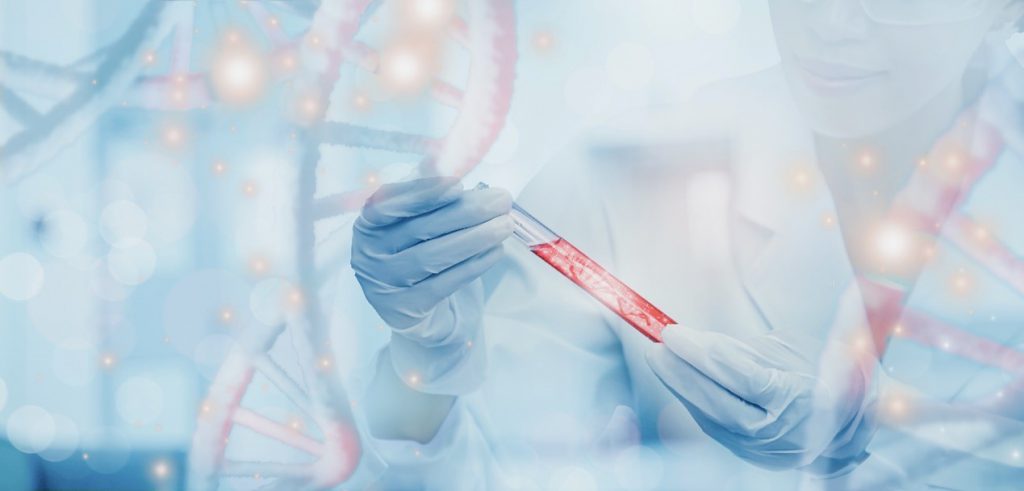
Gold nanoparticles (AuNPs) are small gold particles with a diameter of 1 to 100 nm. Once dispersed in water, AuNPs are also known as colloidal gold.
What are gold nanoparticles used for?
AuNPs have been widely applied in bionanotechnology due to their unique properties and multiple surface functionalities. The ease of AuNP functionalization provides a versatile platform for nanobiological assemblies with oligonucleotides, antibodies, and proteins. Bioconjugates of AuNPs have also become promising candidates in the design of novel biomaterials for the investigation of biological systems.
The versatility of AuNPs has provided useful materials for a range of biomedical applications. In diagnostics, the binding event between the analytes and the AuNPs can alter the physicochemical properties of AuNPs such as surface plasmon resonance, conductivity, and redox behavior, leading to detectable signals. AuNPs also serve as practical platforms for therapeutic agents, with their high surface area allowing a dense presentation of multifunctional moieties (e.g., drugs and targeting agents).
How are gold nanoparticles made?
A wide array of solution-based approaches has been developed in the past few decades to control the size, shape, and surface functionality. Turkevich et al. developed a synthetic method for creating AuNPs in 1951 by treating hydrogen tetrachloroaurate (HAuCl4) with citric acid in boiling water, where the citrate acts as both reducing and stabilizing agent. Frens further refined this method by changing the gold-to-citrate ratio to control particle size. This protocol has been widely employed to prepare to dilute solutions of moderately stable spherical AuNPs with diameters of 10 to 20 nm, though larger AuNPs (e.g., 100 nm) can also be prepared.
In a standard experiment, gold nanoparticles were synthesized according to the procedure described by Turkevich et al., that is chemical reduction of the gold precursor HAuCl4 by dissolved trisodium citrate at 75 °C from aqueous solutions containing 0.25 and 2.5 mmol/L of gold precursor and citrate, respectively.
How can you tell gold nanoparticles?
Colorimetry is a solution-based assay method that by measuring the absorption wavelength, can estimate the concentration of the material in the solution, and according to the specific properties of the gold nanoparticles, based on these particles colorimetry can be a suitable candidate for detection in these particles.
Are gold nanoparticles toxic?
Even though, it is generally accepted that plain gold nanoparticles are toxic both in vitro and in vivo in certain range of concentrations. With proper surface modifications, the toxic effect can be reduced or even eliminated.
About the author
As a leading manufacturer and supplier of various nanoparticles, CD Bioparticles offers a comprehensive list of coated, functional and conjugated gold nanoparticles by precisely surface engineering. We provide gold nanoparticles functionalized with active groups such as NHS, carboxyl, amine, and hydroxyl. And conjugated nanoparticles with a variety of biological ligands are available for your unique requirements.
References
Yeh, Y. C., Creran, B., & Rotello, V. M. (2012). Gold nanoparticles: preparation, properties, and applications in bionanotechnology. Nanoscale, 4(6), 1871-1880.
Polte, J., Ahner, T. T., Delissen, F., Sokolov, S., Emmerling, F., Thünemann, A. F., & Kraehnert, R. (2010). Mechanism of gold nanoparticle formation in the classical citrate synthesis method derived from coupled in situ XANES and SAXS evaluation. Journal of the American Chemical Society, 132(4), 1296-1301.
Jia, Y. P., Ma, B. Y., Wei, X. W., & Qian, Z. Y. (2017). The in vitro and in vivo toxicity of gold nanoparticles. Chinese Chemical Letters, 28(4), 691-702.
Jazayeri, M. H., Aghaie, T., Avan, A., Vatankhah, A., & Ghaffari, M. R. S. (2018). Colorimetric detection based on gold nano particles (GNPs): An easy, fast, inexpensive, low-cost and short time method in detection of analytes (protein, DNA, and ion). Sensing and bio-sensing research, 20, 1-8.
